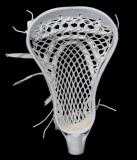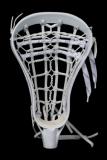|
The Lacrosse Stick (Crosse) is the one piece of equipment that makes lacrosse, lacrosse. It is what defines the game and distinguishes it from all other sports. The stick in ancient times was sacred. All sticks in those days were made by their owners out of wood, and they were all different. Ancient sticks were said to become an extension of their owner. As much a part of their being as their arm or leg. Ornate designs were carved into the sticks, and they were very spiritual in nature. See "Who invented Lacrosse" for more history on the stick and the sport. days were made by their owners out of wood, and they were all different. Ancient sticks were said to become an extension of their owner. As much a part of their being as their arm or leg. Ornate designs were carved into the sticks, and they were very spiritual in nature. See "Who invented Lacrosse" for more history on the stick and the sport.
|
Jump to:
|
|
Europeans were introduced to the ancient game around the 17th century. Legend has it that the missionaries commented on the similarity between the  ancient stick and the Bishops staff or crook which was and is still known as a crosier, and that is where we get the modern name of Lacrosse. From this reference the modern lacrosse stick is technically named the "crosse." Players use the crosse to catch, carry, pass, and shoot the hard rubber ball. They also use the crosse to defend and disrupt opposing players utilizing techniques known as checks to jar the ball loose from the opponents crosse. Or just to impede their opponents direction of travel. ancient stick and the Bishops staff or crook which was and is still known as a crosier, and that is where we get the modern name of Lacrosse. From this reference the modern lacrosse stick is technically named the "crosse." Players use the crosse to catch, carry, pass, and shoot the hard rubber ball. They also use the crosse to defend and disrupt opposing players utilizing techniques known as checks to jar the ball loose from the opponents crosse. Or just to impede their opponents direction of travel.
Ready to Buy a Stick?
Until recent history and the advent and availability of new alloys and plastics, the lacrosse stick was typically made from a single piece of hickory wood. The handle end was straight and the net end was shaped like a triangle or like the crook of a shepherds staff. The net was woven in this area. The old sticks were each said to have a feel that was unique and players would spend hours searching for sticks that felt right in their hands. The old lacrosse stick was much heavier than today's ultra light crosse's as well which made for a much different game than we have now.
With the advent and availability of aluminum and plastic the wood lacrosse stick has  slowly faded away, although you can still buy wooden handles and there are replica sticks still being made from yesteryear, today's lacrosse stick is generally made of two pieces. The handle is typically made from aluminum and the head is made from plastic. The head is the part of the stick that the net is woven into. These new materials are very light and very durable and modern manufacturing processes allow for precision and uniformity of parts which is also a huge improvement from the old sticks. These superior materials have allowed new techniques to develop which give us the tremendously exciting action we have today. slowly faded away, although you can still buy wooden handles and there are replica sticks still being made from yesteryear, today's lacrosse stick is generally made of two pieces. The handle is typically made from aluminum and the head is made from plastic. The head is the part of the stick that the net is woven into. These new materials are very light and very durable and modern manufacturing processes allow for precision and uniformity of parts which is also a huge improvement from the old sticks. These superior materials have allowed new techniques to develop which give us the tremendously exciting action we have today.
In an effort to make the crosse even lighter and stronger and to change characteristics of the shafts flexibility or rigidity today you can find such exotic materials as Titanium, Graphite, Teflon, Scandium, Vandium, Dolomite, and Carbon fiber. The heads are equally as exotic with new designs coming all the time. Each new design claiming to change the shot, passing, holding, or catching characters of the crosse. These exotic materials and designs are fine for the elite athlete who is searching for tiny advantages, and for a stick that will last, but for the beginner or youth players I strongly recommend to save your money and invest in a good quality aluminum, or lower cost titanium, and plastic crosse. The new player will notice little difference and you can save your money for the rest of the gear you will need, such as a helmet, shoulder pads, arm pads, and gloves, etc.. The initial investment on a stick can range anywhere from around $30.00 - $600.00 and up. If you are a brand new player there is no reason you should be spending more than around $130.00 for a very high quality stick.
There are basically three types of sticks to consider:
- Men's Lacrosse Sticks come in lengths from 30" up to a maximum of close to 60".
- Attackmen will typically want a lacrosse stick that is as short as is legal or 30" shaft. The short light stick allows for the attacker to move quickly and to shoot and pass quickly.
- Defenders can use a stick up to 60" and for the defensive player over 5' tall most will choose the maximum length stick which gives them a defensive advantage over the attackmen with the short
 sticks. Teams can only have a total of four long sticks in the game at any one time, so if you are not sure ask your coach before you invest in a long stick. sticks. Teams can only have a total of four long sticks in the game at any one time, so if you are not sure ask your coach before you invest in a long stick.
- Middy's or midfielders may choose to use a stick slightly longer than the 30" attackman stick, because middy's also play defense and the longer 40" shaft gives them a defensive advantage at the sacrifice of some stick speed when shooting.
- Goalies use a special goalie stick that is typically 42" long. With a special head/net that is much larger than other sticks.
- Women's Lacrosse Sticks are very different than the men's sticks. Women's
 sticks measure from 36" up to 44". Again the longer sticks are defensive sticks. The shafts are similar beyond length. Style and color are as much considerations as anything. The major differences between a men's and women's lacrosse stick is the head. Women's heads are shallower and narrower in shape to match the women's game which in some respects is much harder because of the shape of the pocket and the difficulty in retaining the ball in the pocket. Wood is still commonly used in women's lacrosse and wood is an ok material, but the lighter materials help to reduce fatigue. Nevertheless many women still prefer the classic wood stick. sticks measure from 36" up to 44". Again the longer sticks are defensive sticks. The shafts are similar beyond length. Style and color are as much considerations as anything. The major differences between a men's and women's lacrosse stick is the head. Women's heads are shallower and narrower in shape to match the women's game which in some respects is much harder because of the shape of the pocket and the difficulty in retaining the ball in the pocket. Wood is still commonly used in women's lacrosse and wood is an ok material, but the lighter materials help to reduce fatigue. Nevertheless many women still prefer the classic wood stick.
- Youth Lacrosse Sticks can be made entirely of plastic especially for the younger age players. When selecting the first stick for your child contact the coach or league and make sure you are following recommendations. Most groups follow US Lacrosse guidelines, but many leagues have their own twist on the rules. Make sure the stick is not too big for the kid. At younger ages especially a short stick is often better because they can handle it better than a larger stick. As they improve their stick skills you can try going to a longer stick if they are a defender or midfield player which will give them a defensive advantage.
The Lacrosse Stick is made up of three parts:
The shaft is the handle that the player holds. You can buy just the shaft by itself. Typically you will want to match the head with the shaft by manufacturer to ensure a good fit. The shaft itself comes in a variety of shapes. Most are oval, octagonal, or even a combination of the two. This really is a feel thing. Different players will like the way a certain style stick feels better than others. If this is your first stick, unless you are a defensemen I would not recommend a wooden stick for your first stick which is much heavier, and will break.

Shafts will bend or break with hard play. This photo shows an aluminum shaft that is ready to be replaced.
The Head is the plastic or vinyl piece that mounts on the end of the shaft. It is the piece that the net is woven on to. Heads are removable and replaceable. There are many different shaped heads designed to achieve specific results depending on position, shot preference, passing accuracy, and distance, etc..
The Pocket is the net where the ball is caught and thrown from. Pockets are also replaceable. In fact depending on the type of pocket material used the pocket requires the most maintenance of any of your gear. The pocket may need to be changed several times a season with hard use. There are two basic pockets:
Mesh Pockets - are made out of a prefabbed nylon mesh material that comes in varying stiffness's. The harder the mesh typically the more accurate and fast your shots will be. Hard mesh is very consistent and allows players to become very confident in their shots. The down side is that hard mesh is much more difficult to handle. New players will often struggle catching and retaining the ball in the pocket, but as their skills improve they may end up preferring the consistent feel of mesh. The other huge upside is that Mesh needs much less maintenance and adjustment than traditional pockets and for that it is ideal for new players. comes in varying stiffness's. The harder the mesh typically the more accurate and fast your shots will be. Hard mesh is very consistent and allows players to become very confident in their shots. The down side is that hard mesh is much more difficult to handle. New players will often struggle catching and retaining the ball in the pocket, but as their skills improve they may end up preferring the consistent feel of mesh. The other huge upside is that Mesh needs much less maintenance and adjustment than traditional pockets and for that it is ideal for new players.
Traditional pockets - are strung with leather and nylon strings. Traditional pockets can be strung in an unlimited number of ways to change the feel and effectiveness of the shot, or to improve stick handling and catching. Traditional heads need regular maintenance and adjustment. You may have to restring your head a couple of times per season or more. Head stringing though is as much art as anything and learning to string your own head is a very rewarding endeavor that will allow you to personalize your style and Tailor your stick to the strengths and weaknesses of your game. You can effectively change the characteristics of your stick just by tightening or loosening your strings. pockets can be strung in an unlimited number of ways to change the feel and effectiveness of the shot, or to improve stick handling and catching. Traditional heads need regular maintenance and adjustment. You may have to restring your head a couple of times per season or more. Head stringing though is as much art as anything and learning to string your own head is a very rewarding endeavor that will allow you to personalize your style and Tailor your stick to the strengths and weaknesses of your game. You can effectively change the characteristics of your stick just by tightening or loosening your strings.
Coming soon: Stringing techniques and how to. Stay tuned.
Shop for Lacrosse Sticks
|